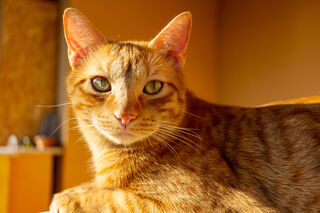Key points
- Gender roles can influence how people interact with their pets.
- One scientist suggests men can improve their relationship with their cats by feeding them several days in a row and getting down to their level.
- Research shows men are more likely than women to use outdated aversive dog-training methods.
- Relationships with pets can be a way to move out of traditional gender roles.

Even though it’s 2022, gender roles still shape stereotypes and behaviour. A recent paper by Dennis Turner set me thinking about how they influence people’s relationships with their pets. Turner has contributed immensely to our understanding of our feline friends and based on an overview of feline science he writes about unanswered research questions about cats. One of his suggestions is:
“On a more practical level, men sometimes complain that household cats prefer to interact with the women in an abode (or even like them better). During public lectures, the author has often suggested that they feed the cats several days in a row (which often women regularly do), and/or to move down to the level of the animals when interacting (which women have been found to do, Mertens [1991]) to elicit a change in the cats’ interactive behavior. These are but two simple manipulations, which have never been tested but show promise for improving the men’s relationships.”
The study he references by Mertens (1991) found that the best feline relationships in a home setting were between women and their cats (the worst were between pairs of young cats).
When we think about dogs, although I have not been able to find data on the demographics of dog trainers and the methods they use, there is a sense that women are more likely to use reward-based methods, whereas men are more likely to be balanced or aversive trainers. As for dog guardians, there is some data that shows men are more likely to use a combination of aversive and reward-based methods, rather than just reward-based methods (Woodward et al, 2021). Men are also more likely to use electronic shock collars than women (Blackwell et al 2012).
This matters because we know that the use of aversive methods (such as shock and prong collars and leash jerks) is associated with risks to the dog’s welfare and the dog having a worse relationship with their guardian (see e.g. Ziv, 2017; Vieira de Castro, 2019).
Why men and women train dogs differently
There could be several reasons for this gendered difference in approaches to training. In a thoughtful piece on gender and dog training methods in Norway, Ane Møller Gabrielsen writes:
“The question is not why women opt for ‘positive’ methods, such as clicker training, because non-aversive methods have become the norm in dog training, and so have women.”
She goes on to say that using aversive methods in dog training may be a way of performing gender. She quotes a clicker trainer’s explanation for this:
“When you want it to be a bit tough, when you want some testosterone and action, then you go for the traditional methods.”
Of course, this is a shame for dogs, given the risks of those traditional, aversive methods. (In fact, although aversive methods are seen as traditional, positive reinforcement and kindness have been around for a long time too).
The link between training methods and gender roles is also considered by Dr. Harlan Weaver, who says that reward-based approaches are easily associated with feminism (Weaver, 2017). He says:
“A critical disparity in the R+ [positive reinforcement] versus dominance debates involves different understandings of the roles of love, happiness, and respect in training.”
Further:
“The disparity between the approaches seemingly hinges on the ways that R+ involves a caring cultivation of happiness that can be easily, if loosely, connected to feminist ethics, while dominance leans more heavily on respect in the form of obedience.”
Of course, it is not so simple a dichotomy, as Weaver acknowledges. Both types of trainers care for their dogs, albeit in different ways.
The shift to increased use of positive methods is associated with what might be termed the “feminisation” of dog training and dog sports (Charles et al, 2021). Charles et al. point out that some types of positive reinforcement dog training can co-exist with masculine ideas of hierarchy and dominance, in that they still require obedience from the dog. Meanwhile, other types of training question those ideas and now see the relationship with the dog as more of a partnership than a hierarchy.
Pets offer a way out of gender roles
But relationships with pets don’t have to be constrained by gender roles. In some cases, those relationships may even offer a way out of them; with a pet, some men may not feel the need to perform masculinity. In their book on Men and Their Dogs, Chris Blazina and Lori Kogan write:
“We argue that animal companions offer many men a respite from the strain of traditional male gender roles. The shared bond may also be one that prompts transformation in males’ lives.”
Obviously, this is a complex topic and I am only scratching the surface of how gender may influence the human-animal bond and how we care for pets. As well, gender is only one of many factors that may affect people’s relationship with their pets.
Turner’s questions about men and their cats are currently unanswered, and they raise yet more interesting questions about gender roles and pets. But there are some lessons we can take from this if we want: Feeding the pet, getting down to their level rather than towering over them, and using reward-based training methods (because they are effective and better for the pet’s welfare) may help you have a better relationship with your dog or cat. And if these actions lead to more equity in the home through more sharing of responsibilities, it may also improve human relationships too.
It turns out that your relationship with your dog or cat is a good starting point for considering wider societal power relations. Even pets are political.





